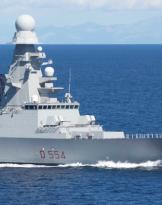The eventual confrontation between Taiwan and China immediately brings to mind the biblical story of David versus Goliath.
So Taiwan would be doomed to succumb in the event of a Chinese invasion (net of US aid)? Or could the PLA (People's Liberation Army) face tremendous resistance, which would ultimately lead to the failure of Beijing's plans?
In elaborating a synthesis of Taipei's defensive capabilities against an invasion force, we should first of all analyze the geographic conformation of the island of Taiwan.
We remind you that it is not a single island, in fact there are some islets administered by Taipei, such as Klinmen, just 3 km from the Chinese province of Fujian, or the small archipelago of Matsu, which is located 15 km from the city of Fuzhou.
Due to its coastal conformation, Taiwan does not lend itself to an amphibious invasion.
We are talking about an island that extends for almost 400 km (from north to south), with a maximum width of 150 km (from west to east).
The Taiwanese territory is divided into two parts: the flat plains of the west, where 90% of the population resides, and mountains almost totally covered with tropical forest that occupy two thirds of the eastern land. The tallest massif in Taiwan is Yushan, whose peak reaches 4.000 m.
 The seabed is shallow, about 60 m of average depth, (this facilitates the placement of naval mines) and navigation is very difficult. There are very few areas of the coast capable of "accommodating" a landing force. On the east coast, however, the seabed is deeper but the projection of an invasion force in depth would be immediately blocked as it would be in front of the mountain ranges.
The seabed is shallow, about 60 m of average depth, (this facilitates the placement of naval mines) and navigation is very difficult. There are very few areas of the coast capable of "accommodating" a landing force. On the east coast, however, the seabed is deeper but the projection of an invasion force in depth would be immediately blocked as it would be in front of the mountain ranges.
In addition to minefields, Taipei can deploy a wide range of supersonic / hypersonic missiles in anti-Chinese operation. Taiwan devotes a considerable portion of its Defense Budget (over $ 10 billion annually) to the development of anti-ship systems.
NCSIST (National Chung Shan Institute of Science and Technology) is involved in the development and production of missile systems for the Taiwanese Armed Forces.
Its main products are the supersonic anti-ship Hsiung Feng II / III (400 km of maximum range) and the Hisiung Feng IIE cruise missile (up to 1.000 km of maximum range). The latter was designed to hit the bases on the territory of the People's Republic of China, the missile has a speed exceeding 1.000 km / h, and would fly in hostile territory at a maximum altitude of 30 m.
Additionally, in 2019, the Navy received a large supply of R-AGM-84L Block II anti-ship missiles. Harpoon (120 km of maximum range), can be launched from both naval (photo) and aerial platforms.

In 2017 the then Trump administration approved the supply of the AGM-154C JSOW air-to-surface missiles using a seeker IIR (Imaging Infrared) and are equipped with a BROACH head (multistage head), specially designed to penetrate highly protected targets (such as buried bunkers).
Taiwan was very interested in the 5th generation STOVL F-35B fighter, in order to have an aircraft, with short take-off and vertical landing, able to operate even outside the airport structures (safe targets for a possible Chinese attack). However, Washington preferred to reject this request so as not to increase the tension with Beijing.
In the event of an attack, Taiwan would therefore try to hit the largest number of naval units of the PLAN, launching missile attacks also against military targets on Chinese soil.
From 4 to 7 August Beijing will carry out a large air and naval exercise around Taiwan, we will see if it will be a showy show of strength or preparations for a real invasion.
Strangely, it was not the arms supplies to Taipei that caused a surge in tension between the United States and China, but the visit of a senior American politician, as Beijing considers Taiwan a secessionist province that, sooner or later, it will have to rejoin mainland China if necessary manu militar.
Photo: MoD People's Republic of China / Twitter / US Navy












